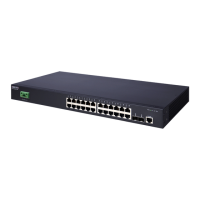Chapter 2
| Using the Command Line Interface
CLI Command Groups
– 83 –
CLI Command Groups
The system commands can be broken down into the functional groups shown
below
.
Table 6: Command Group Index
Command Group Description Page
General Basic commands for entering privileged access mode,
restarting the system, or quitting the CLI
87
System Management Display and setting of system information, basic modes of
operation, maximum frame size, file management, console
port and telnet settings, system logs, SMTP alerts, the system
clock, and switch clustering
95
Simple Network
Management Protocol
Activates authentication failure traps; configures community
access strings, and trap receivers
177
Remote Monitoring Supports statistics, history, alarm and event groups 203
Flow Sampling Samples traffic flows, and forwards data to designated
collector
211
User Authentication Configures user names and passwords, logon access using
local or remote authentication, management access through
the web server, Telnet server and Secure Shell; as well as port
security, IEEE 802.1X port access control, restricted access
based on specified IP addresses, and PPPoE Intermediate
Agent
217
General Security Measures Segregates traffic for clients attached to common data ports;
and prevents unauthorized access by configuring valid static
or dynamic addresses, web authentication, MAC address
authentication, filtering DHCP requests and replies, and
discarding invalid ARP responses
279
Access Control List Provides filtering for IPv4 frames (based on address, protocol,
TCP/UDP port number or TCP control code), IPv6 frames
(based on address, or non-IP frames (based on MAC address or
Ethernet type)
361
Interface Configures the connection parameters for all Ethernet ports,
aggregated links, and VLANs
385
Link Aggregation Statically groups multiple ports into a single logical trunk;
configures Link Aggregation Control Protocol for port trunks
425
Power over Ethernet
*
Configures power output for connected devices 439
Mirror Port Mirrors data to another port for analysis without affecting the
data passing through or the performance of the monitored
port
447
Congestion Control Sets the input/output rate limits, traffic storm thresholds, and
thresholds for broadcast and multicast storms which can be
used to trigger configured rate limits or to shut down a port.
457
UniDirectional Link
Detection
Detect and disables unidirectional links 481
Address Table Configures the address table for filtering specified addresses,
displays current entries, clears the table, or sets the aging time
489
Spanning Tree Configures Spanning Tree settings for the switch 495

